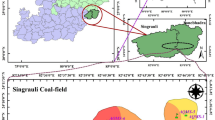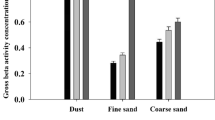Abstract
PM-10, PM-2.5 and PM-1.0 concentrations were measured over an 8 h period at sites both inside and outside the museum of Wawel Royal Castle in Cracow, Poland. Gross alpha (α) and beta (β) activities seemed to vary across the particle size range with generally higher levels of activities in the PM-2.5 particle fraction, and higher activities in the PM-10 fraction, while both the highest and the lowest beta activities were found in PM-1.0 fraction. However, statistically there was no significant difference. The highly radioactive PM-1.0 fraction comprised mainly 210Pb and the 210Pb progeny, 210Bi and 210Po, and can be attributed to anthropogenic sourced outdoor radioactive particles brought indoors by visitors. 210Pb is considered to be a good tracer of secondary aerosols produced by gas-to-particle conversion. Inside the Museum, the highest level of gross alpha activity was detected in the PM-10 fraction, and was mainly due to the uranium isotopes (234U, 235U and 238U) and their daughter products (226Ra, 232Th, 210Po or 224Ra), and 137Cs. The minimum and maximum total indicative doses per 8 h are caused by 137Cs and 232Th, respectively.





Similar content being viewed by others
References
UNSCEAR (2000) United Nations Scientific Committee on the effects of atomic radiation, report vol 2. United Nations Sales Publication, New York, E.00.IX.4, ISBN92-1-142239-6
Grabowska S, Mietelski JW, Kozak K, Gaca P (2003) J Atmos Chem 46:103–116
Acena M, Crespo MT (1989) CIEMAT-635 Madrid 26
Sheets RW, Thompson CC (1992) J Radioanal Nucl Chem 161:465–474
Papastefanou C (1994) Nucl Geophys 8:39–43
Gomez EV, Vera Tome F, Sanchez AM (1996) J Environ Radioact 31:273–285
Lambert MP (1994) Collect Forum 10:65–80
Waller EJ, Cole D, Jamiesson T (2008) Health Phys 94:S16–S20
Currie LA (1968) Anal Chem 40:586–593
EPA (1980) EPA/600/4-80-032
Esmeray E (2005) MSc thesis, Selcuk University Graduate School of Natural and Applied Sciences, Konya, p 25
EPA (1988) Federal guidance report no. 11 EPA report 520/l-88-020
Karaca F, Alagha O, Erturk F, Taskın H (2004) 3rd GIS days. Istanbul, Turkey
Junge CE (1963) Academic Press, San Diego, CA, pp 209–288
Sanak J, Gaudry A, Lambert G (1981) Geophys Res Lett 8:1067–1069
Blanchard RL, Hahne RM, Kohn B, McCurdy D, Mellor RA, Moove WS, Sedlet J, Whittaker E (1985) Health Phys 48:587–600
TAEK (2006) Series of Chernobyl no: 7, ISBN 975-8898-19-1
Author information
Authors and Affiliations
Corresponding author
Rights and permissions
About this article
Cite this article
Akbulut, S., Krupińska, B., Worobiec, A. et al. Gross alpha and beta activities of airborne particulate samples from Wawel Royal Castle Museum in Cracow, Poland. J Radioanal Nucl Chem 295, 1567–1573 (2013). https://doi.org/10.1007/s10967-012-1983-8
Received:
Published:
Issue Date:
DOI: https://doi.org/10.1007/s10967-012-1983-8




